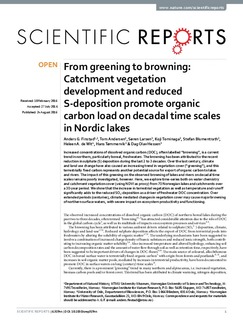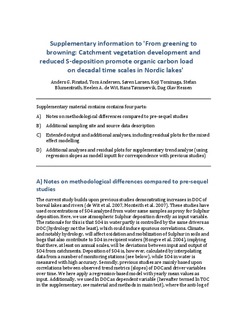| dc.contributor.author | Finstad, Anders Gravbrøt | |
| dc.contributor.author | Andersen, Tom | |
| dc.contributor.author | Larsen, Søren | |
| dc.contributor.author | Tominaga, Koji | |
| dc.contributor.author | Blumentrath, Stefan | |
| dc.contributor.author | de Wit, Heleen | |
| dc.contributor.author | Tømmervik, Hans | |
| dc.contributor.author | Hessen, Dag Olav | |
| dc.date.accessioned | 2016-09-06T11:46:38Z | |
| dc.date.accessioned | 2016-09-09T06:47:27Z | |
| dc.date.available | 2016-09-06T11:46:38Z | |
| dc.date.available | 2016-09-09T06:47:27Z | |
| dc.date.issued | 2016 | |
| dc.identifier.citation | Scientific Reports 2016, 6 | nb_NO |
| dc.identifier.issn | 2045-2322 | |
| dc.identifier.uri | http://hdl.handle.net/11250/2405610 | |
| dc.description.abstract | Increased concentrations of dissolved organic carbon (DOC), often labelled “browning”, is a current
trend in northern, particularly boreal, freshwaters. The browning has been attributed to the recent
reduction in sulphate (S) deposition during the last 2 to 3 decades. Over the last century, climate
and land use change have also caused an increasing trend in vegetation cover (“greening”), and this
terrestrially fixed carbon represents another potential source for export of organic carbon to lakes
and rivers. The impact of this greening on the observed browning of lakes and rivers on decadal time
scales remains poorly investigated, however. Here, we explore time-series both on water chemistry
and catchment vegetation cover (using NDVI as proxy) from 70 Norwegian lakes and catchments over
a 30-year period. We show that the increase in terrestrial vegetation as well as temperature and runoff
significantly adds to the reduced SO4-deposition as a driver of freshwater DOC concentration. Over
extended periods (centuries), climate mediated changes in vegetation cover may cause major browning
of northern surface waters, with severe impact on ecosystem productivity and functioning. | nb_NO |
| dc.language.iso | eng | nb_NO |
| dc.publisher | Nature Publishing Group | nb_NO |
| dc.rights | Navngivelse 3.0 Norge | * |
| dc.rights.uri | http://creativecommons.org/licenses/by/3.0/no/ | * |
| dc.title | From greening to browning: Catchment vegetation development and reduced S-deposition promote organic carbon load on decadal time scales in Nordic lakes | nb_NO |
| dc.type | Journal article | nb_NO |
| dc.type | Peer reviewed | nb_NO |
| dc.date.updated | 2016-09-06T11:46:38Z | |
| dc.source.volume | 6 | nb_NO |
| dc.source.journal | Scientific Reports | nb_NO |
| dc.identifier.doi | 10.1038/srep31944 | |
| dc.identifier.cristin | 1376748 | |
| dc.description.localcode | This work is licensed under a Creative Commons Attribution 4.0 International License. The images or other third party material in this article are included in the article’s Creative Commons license, unless indicated otherwise in the credit line; if the material is not included under the Creative Commons license, users will need to obtain permission from the license holder to reproduce the material. To view a copy of this license, visit http://creativecommons.org/licenses/by/4.0/ | nb_NO |


